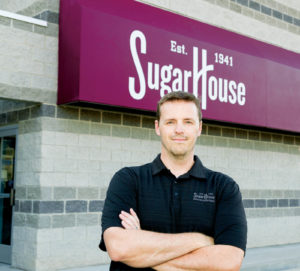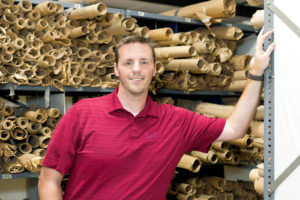 Mike Peterson restructures an awning company’s culture by asking hard questions, collaborating on the answers, and fearlessly changing the rules.
Mike Peterson restructures an awning company’s culture by asking hard questions, collaborating on the answers, and fearlessly changing the rules.
Our old philosophy was to focus on profitability and the end result—and in order to get there we did our best to take care of our customers, and our employees came last,” says Mike Peterson, president and part owner of SugarHouse Awning Industries in Salt Lake City, Utah. “My philosophy is to flip that around and say if we work to build up our employees, develop them and help them engage, they will take care of the customers—and the profits will follow.”
In 1941, Peterson’s grandfather and his business partner launched the company in one of Salt Lake City’s oldest neighborhoods, known as Sugar House. The United States entered World War II shortly after that, bringing all the challenges and resource drains that come with war. Soon, the partner moved on to other endeavors; Peterson’s grandfather became sole owner, and the business was officially named SugarHouse Awning.
Like many in the awning industry, Mike Peterson grew up in and around the business, went off to college to explore other career options but returned to the family business after marrying and recognizing the opportunity that was available there. He grew to love the work and the people he works with at SugarHouse, which now manufactures marine canvas products and signs and banners, as well as awnings and other custom work.
Over the years, Peterson worked his way up through the ranks and now has been president of the company for three years. He shares ownership with 10 other family members, including siblings, cousins and their children. “I think we’re fortunate that we haven’t had a lot of drama or other issues that can arise with family businesses that have a lot of hands in the pot, so to speak,” Peterson says. “I think it’s mostly due to my grandpa’s foresight in how he set up the ownership. You can’t be an owner if you don’t work here. Essentially, the idea was that outside owners who aren’t part of the business often have different ideas and priorities than those directly involved with the business, which can lead to fighting and conflict and ultimately bring down a company.”
 An axe to grind
An axe to grind
One of the first things Peterson did when he became president was to share with the management team a parable he felt summed up the challenge SugarHouse was facing. “There was a man in the woods trying to cut down a tree,” Peterson says. “A wise old farmer came by and watched him for a minute before saying, ‘You look exhausted. How long have you been trying to cut down that tree?’ The man answered, ‘All day. It’s really hard work.’ The farmer advised, ‘Your axe is dull. Why don’t you take a few minutes to sharpen it so you can get your work done faster?’ And the man replied, ‘I don’t have time to sharpen my axe. I’m too busy working.’”
“To me, that pretty much summed up our work culture here for the last many years,” Peterson says. “Everybody was very production-minded. They put their heads down and worked harder, longer, more hours, just to get the work done. I started to realize the managers didn’t really know what they needed to know to manage effectively.”
Of truth and training
Based on that realization, Peterson’s first focus when he became president was management training. “I wanted to help management understand that if they could step back from their work, ‘sharpen their axe’ and start managing, we could get more work done with a lot less stress, and also become more profitable,” he says.
He began the process by hiring consultants to train managers as a group, as well as individually—and the first person the consultants worked with was Peterson. “They did a pre-interview with me to get a feel for the company and what it’s like to work in a family business, and I joked that the worst part is that my tongue really hurts from constantly biting it, meaning I didn’t feel it was okay to talk about problems or get after somebody because they weren’t meeting expectations,” Peterson says.
“It didn’t take long for me to realize that was not the way to run a business.”
The consultants helped the team learn how to identify and deal with problems as they arise. “We’ve gotten much better at being honest, holding people accountable and helping them improve,” Peterson says. “It’s been eye-opening for me. Most of the time people appreciate my honesty in pointing out whatever the problem is, and helping them get to a better place.”
 Replacing annual reviews
Replacing annual reviews
With a degree in psychology, Peterson places importance on the “soft skills” and building stronger employee relations. One of the changes he’s made in an attempt to improve morale is to do away with annual performance reviews. “We’ve done annual performance reviews for as long as I can remember, and they were a terrible thing for us. Managers didn’t like them and employees dreaded them,” he says. “They usually caused more problems than they did any good.”
Peterson has replaced the annual reviews with monthly coaching meetings. Each manager is expected to meet monthly with each of their employees. “It doesn’t have to be a long meeting and it doesn’t always have to be formal,” he says. “The idea is just to sit down together and communicate—listen to the employee and help them develop as a person and as an employee. I’ve told the managers, even if all you get out of this is a good conversation with your employee, that’s a step in the right direction. Of course, I hope they’ll also be able to set goals and work on removing obstacles that keep people from doing their jobs well.”
On the books
Perhaps the most helpful change at the company is the launch of a monthly book club for the management team. Each month, every manager reads the same management/leadership book (or listens to it on the company’s audible account), and one person is assigned to lead a discussion about it. “At first I think everybody was a bit hesitant about it,” Peterson says. “But we’ve done it for probably two years now and I think they really enjoy it and look forward to learning something new. I think it’s made a big difference in education, insights and skills.”
As Peterson and the management team continue to look for new ways to develop their skills and improve the company, they rely on the vision statement they developed last year to help guide them. “This was a new thing for us, but we thought it was important to understand why we’re doing what we’re doing,” Peterson says. “So we spent months going over ideas and looking back to our roots. Finally, we distilled it down to this: SugarHouse is a family business, and we consider all of our employees and customers to be a part of the family. We are here to take care of and make life better for all members of the SugarHouse family.”
At the end of the day it’s not so much about awnings or boat covers or banners,” Peterson continues. “It’s not really even about making money. It’s about taking care of that extended family.”

When the visitor center at the Great Salt Lake Shorelands Preserve in Layton, Utah, needed new shade panels on an existing log structure, managers contacted SugarHouse Awning for the job. The preserve is a resting point and feeding ground for migrating birds on their way from Canada to Central and South America, and visitors can view the bird-filled mudflats, salt and fresh water marshes and sloughs from the log structure. “The project was challenging due to the location and lack of accessibility of the structures,” president Mike Peterson says. “The structures were more than a half mile from the main road and there was no vehicle accessibility to them—just narrow boardwalks. We ended up using climbing and rappelling gear to maneuver around the structures to measure and install the panels.”
The SugarHouse Awning crew manufactured approximately 3,000 square feet of shade sails using Twitchell Textiline® 95 solar screen fabric from Trivantage. Most of the panels were 10 feet wide by 20 feet long. “The panels were also a challenge due to all the unique geometric shapes and the unpredictable nature of the log structure,” Peterson says. “We came up with a new and better way to attach the panels to the structure than the previous panels used, which made for a much tighter and better-looking fit.”
1. Hire consultants to train the management team, as a group and as individuals.
2. Be available to your management team. Offer support to help them understand what you expect.
3. Make use of existing resources on the topic. Read management and leadership training books, and discuss as a team.
4. Be honest with each other and hold each other accountable. Deal with problems as soon as they arise.
5. Do away with annual performance reviews and replace them with more frequent, less formal meetings between managers and employees.
How have you improved the production process so people can work smarter?
Our awning department was our biggest problem, with late jobs and upset customers—and it wasn’t because the crew wasn’t working hard. They were. But our communication was terrible, both in-house and with the customers. I developed an in-house scheduling tool to help us with planning, organization and scheduling. The change has literally transformed our awning department. We now have someone spending 20 to 30 hours a week focusing on planning, scheduling and communicating with customers. We used to spend maybe five hours a week on that stuff, if we were lucky. The change has taken us from being inefficient, with a lot of overtime, to getting everything done in a 40-hour work week with time to spare.
How do you communicate the company expectations to employees?
We want the business to focus on being a family, and every family has rules, so we came up with an acronym that lays out those expectations: RULES.
R: Reliability. We keep our promises.
U: Unity. We work as a team. We’re in this together.
L: Love. We’ve got to love what we do and love who we do it with.
E: Evolve. We don’t want to just be good enough. We want to continually improve.
S: Service. We want our customers to be glad they did business with us and to come back often.
 TEXTILES.ORG
TEXTILES.ORG


